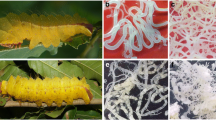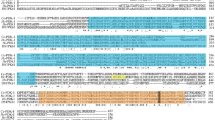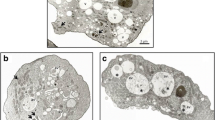Abstract
The cloned enolase gene of Angiostrongylus cantonensis (AcEno) comprised 1,667 bp and encoded a peptide with 434 amino acid residues which lacked of a signal peptide but contained a transmembrane region, indicating that AcEno tends to be a structural component (intracellular or membrane protein). The real-time PCR revealed a meaningful difference in the expression level of AcEno in varied development stages. By immunolocalization, native AcEno was detected mainly in the cytoplasm in most tissues, such as parietal muscle, genital tracts, nerve ring, and alimentary canal where the energy consumption is high, but not as expected on the cuticle and hypodermis layer of the nematode. This suggests that the AcEno may be involved in a host of other biological functions, rather than a receptor of plasminogen or a component of excretory–secretory antigen. In addition, AcEno expressed alike in the nucleus, indicating that AcEno also involved in regulating the continuous growth and development of A. cantonensis in hosts. Despite of living in the vasculature at a certain stage of life cycle, AcEno was not localized in the outer surface of L3 and adults, indicating that A. cantonensis may have other virulence and immune evasion mechanisms.








Similar content being viewed by others
References
Al-Giery AG, Brewer JM (1992) Characterization of the interaction of yeast enolase with polynucleotides. Biochim Biophys Acta 1159:134–140
Bernal D, de la Rubia JE, Carrasco-Abad AM, Toledo R, Mas-Coma S, Marcilla A (2004) Identification of enolase as a plasminogen-binding protein in excretory-secretory products of Fasciola hepatica. FEBS Lett 563:203–206
Bhowmick IP, Kumar N, Sharma S, Coppens I, Jarori GK (2009) Plasmodium falciparum enolase: stage-specific expression and sub-cellular localization. Malar J 8:179–194
Braschi S, Verjovski-Almeida S, Wilson A, Curwen RS, Ashton PD (2006) The tegument surface membranes of the human blood parasite Schistosoma mansoni: a proteomic analysis after differential extraction. Proteomics 6:1471–1482
Chen N, Xu M, Nisbet AJ, Huang C, Lin R, Yuan Z, Song H, Zhu X (2011) Ascaris suum: RNAi mediated silencing of Enolase gene expression in infective larvae. Exp Parasitol 127:142–146
de la Torre-Escudero E, Manzano-Román R, Pérez-Sánchez R, Siles-Lucas M, Oleaga A (2010) Cloning and characterization of a plasminogen-binding surface-associated Enolase from Schistosoma bovis. Vet Parasitol 173:76–84
Desjardins CA, Regier JC, Mitter C (2007) Phylogeny of pteromalid parasitic wasps (Hymenoptera: Pteromalidae): initial evidence from four protein-coding nuclear genes. Mol Phylogenet Evol 45:454–469
Gan W, Zhao G, Xu H, Wu W, Du W, Huang J, Yu X, Hu X (2010) Reverse vaccinology approach identify an Echinococcus granulosus tegumental membrane protein Enolase as vaccine candidate. Parasitol Res 106:873–882
Han K, Xu L, Yan R, Song X, Li X (2012) Molecular cloning, expression and characterization of Enolase from adult Haemonchus contortus. Res Vet Sci 92:259–265
Jolodar A, Fischer P, Bergmann S, Büttner DW, Hammerschmidt S, Brattig NW (2003) Molecular cloning of an alpha-Enolase from the human filarial parasite Onchocerca volvulus that binds human plasminogen. Biochim Biophys Acta 1627:111–120
Livak KJ, Schmittgen TD (2001) Analysis of relative gene expression data using real-time quantitative PCR and the 2(−delta delta C (T)) method. Methods 25:402–408
Mulvenna J, Moertel L, Jones MK, Nawaratna S, Lovas EM, Gobert GN, Colgrave M, Jones A, Loukas A, McManus DP (2010) Exposed proteins of the Schistosoma japonicum tegument. Int J Parasitol 40:543–554
Nakada T, Nagano I, Wu Z, Takahashi Y (2005) Molecular cloning and functional expression of Enolase from Trichinella spiralis. Parasitol Res 96:354–360
Ni F, Wang Y, Zhang J, Yu L, Fang W, Luo D (2012) Cathepsin B-like and hemoglobin-type cysteine proteases: stage-specific gene expression in Angiostrongy cantonensis. Exp Parasitol 131:433–441
Pancholi V (2001) Multifunctional α-enolase: its role in diseases. Cell Mol Life Sci 58:902–920
Pancholi V, Chhatwal GS (2003) Housekeeping enzymes as virulence factors. Int J Med Microbiol 293:391–401
Pérez-Sánchez R, Ramajo-Hernández A, Ramajo-Martín V, Oleaga A (2006) Proteomic analysis of the tegument and excretory-secretory products of adult Schistosoma bovis worms. Proteomics 6:226–236
Plow EF, Das R (2009) Enolase-1 as a plasminogen receptor. Blood 113:5371–5372
Ramajo-Hernández A, Pérez-Sánchez R, Ramajo-Martín V, Oleaga A (2007) Schistosoma bovis: plasminogen binding in adults and the identification of plasminogen-binding proteins from the worm tegument. Exp Parasitol 115:83–91
Takei N, Kondo J, Nagaike K, Oshawa K, Kato K, Kohsaka S (1991) Neuronal survival factor from bovine brain is identical to neuron-specific enolase. J Neurochem 57:1178–1184
Van Balkom BWM, Van Gestel RA, Brouwers JFHM, Krijgsveld J, Tielens AGM, Heck AJR, Van Hellemond JJ (2005) Mass spectrometric analysis of the Schistosoma mansoni tegumental sub-proteome. J Proteome Res 4:958–966
Vanegas G, Quiñones W, Carrasco-López C, Concepción JL, Albericio F, Avilán L (2007) Enolase as a plasminogen binding protein in Leishmania mexicana. Parasitol Res 101:1511–1516
Williams LA, Ding L, Horwitz J, Piatigorsky J (1985) Tau-crystallin from the turtle lens: purification and partial characterization. Exp Eye Res 40:741–749
Yang J, Qiu C, Xia Y, Yao L, Fu Z, Yuan C, Feng X, Lin J (2010) Molecular cloning and functional characterization of Schistosoma japonicum Enolase which is highly expressed at the schistosomulum stage. Parasitol Res 107:667–677
Yatsuda AP, Krijgsveld J, Cornelissen AW, Heck AJ, de Vries E (2003) Comprehensive analysis of the secreted proteins of the parasite Haemonchus contortus reveals extensive sequence variation and differential immune recognition. J Biol Chem 278:16941–16951
Yu C, Wang Y, Zhang J, Fang W, Luo D (2014) Immunolocalization and developmental expression patterns of two cathepsin B proteases (AC-cathB-1, −2) of Angiostrongylus cantonensis. Exp Parasitol. doi:10.1016/j.exppara.2014.06.008
Acknowledgments
The project was supported by the Natural Science Foundation of China (Grant No. 81171595).
Author information
Authors and Affiliations
Corresponding author
Rights and permissions
About this article
Cite this article
Zhang, J., Yu, C., Wang, Y. et al. Enolase of Angiostrongylus cantonensis: more likely a structural component?. Parasitol Res 113, 3927–3934 (2014). https://doi.org/10.1007/s00436-014-4056-9
Received:
Accepted:
Published:
Issue Date:
DOI: https://doi.org/10.1007/s00436-014-4056-9




